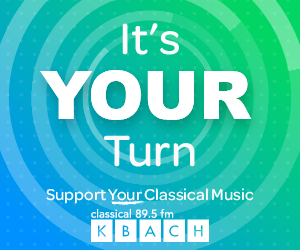Click to Listen:

Musicians' thoughts on "Emperor";
Apple Music Fails in Classical
TWICM 022419
It’s “This week in Classical Music”; an update on what’s happening in classical music; I’m Randy Kinkel.
There’s a big gap between the way classical music is introduced to lay listeners and the way musicians experience it.
We tend to offer classical music to audiences like a history lesson, studded with names and dates that don’t really get to the heart of what you hear.
Musicians experience it differently.
In anticipation of Beethoven’s 250th anniversary year in 2020, writer Anne Midgette went to find a new view of the Emperor Concerto by talking to some of the artists who have played it recently, and learned a lot.
“The rhythmic life of the first movement is super-square,” says James Ross, music director of the Alexandria Symphony …”For me, the first movement goes on longer than the material warrants.”
Lachezar Kostov, cellist of the Baltimore Symphony, says “Beethoven was the biggest revolutionary when it came to orchestral cello writing.” the composer gave a lot of thematic material to cellos and violas. Daniel Foster, violist of the National Symphony, says there’s no Beethoven piece that he doesn’t look forward to playing. But, he adds, “With Beethoven, “there can be awkward jumps, or it’s harder to find a fingering that really works.”
‘The horn parts in the Emperor get more bang for their buck, with less nervous tension, than nearly any other piece of Beethoven’s,” says Ross, who began his career as a horn player and was the first American in Leipzig’s Gewandhaus orchestra. “everything we play sounds good.”
For Jauvon Gilliam, the NSO’s principal timpanist, one of the challenges is the timpani cadenza, with the piano soloist, that closes out the final movement. “Every soloist wants it different,” he says.
For orchestra players, a concerto, even one as long and demanding as the Emperor, can be more relaxed. “It’s not as intense an experience as doing one of the symphonies,” says violist Foster. The focus is on the soloist, who has to deliver 40 minutes of playing, at the upper and lower extremes of the instrument, with all ears on him.
pianist Pierre-Laurent Aimard, who played the piece at the Kennedy Center last week. “every time it’s an impressive challenge. Aimard sees the piece in light of its own history, written at a time when Napoleon’s forces were besieging Vienna.“It is anything but beautiful and aesthetic,” he says. “It is a shout for freedom.”
Last August, Apple Music was updated with a new section in “Browse” curated by the record label Deutsche Grammophone, one of the biggest classical music labels in the world.
While classical music fans welcomed the specific focus of the area, many quickly pointed out the many issues that remain for classical listeners on a daily basis within Apple Music, and the fact that they've been there since the launch of the service with seemingly no correction in sight.
one problem is that Classical music is treated as a single genre. When you tap on "Genres" in Apple Music's Browse tab, you'll get a list of over 30 styles of music, from Alternative and African Music to Christian, Electronic, K-Pop, and Metal. Critics say they’re treating 300 years of music as one genre.
can you imagine how strange it would be to group LL Cool J, Metallica, and The Spice Girls together? These are all artists that were popular in the 90s; beyond that, they have virtually nothing in common. Grouping together Mozart, Ravel, and Cage makes the same amount of sense.
Because of the wordy titles, any voice features touted by Apple and found within Apple Music are much harder to use for classical music fans.
As Charles bluntly puts it, "Can you imagine: 'Hey Siri, play the third movement of Prokofiev's Piano Concerto No. 3 from the album Prokofiev: Piano Concerto No. 3 in C Major, Op. 26 - Ravel: Piano Concerto in G Major, M.83; Gaspard de la nuit, M. 55 by Martha Argerich, Berlin Philharmonic & Claudio Abbado."
In the same vein, Rumiz says more categories would do wonders for expanding the ease-of-use of classical on Apple Music, by offering more complex categories like "soloist" and "conductor," instead of following the rules of pop and rock music where songs only have one artist. While this would be a big task for Apple, Rumiz notes that it will be "necessary if they want classical music fans to continue using Apple Music on the long run."
Overall, Charles is hoping for Apple to boost the intelligence of its classical music section on Apple Music. To start, he recommends Apple hire a musicologist whose job it would be to personally back the rejuvenation of the classical music features on the service. This would be just like most other sections of Apple Music, where algorithms are backed and double-checked by human editors,
According to Rumiz, a well-organized and fully featured suite of classical video content "could be an important selling point" for a streaming service intent on gaining more classical fans. there are millions of classical music fans willing and ready to pay the company that can get these things right. "This is a completely untapped market," Charles tells me. "One streaming service could completely own the classical music audience if it wanted to."
For more on these and other items and events, go to the website, KBACH.org; be listening every week at this time for another update; find us on Facebook and twitter; check out the KBACH top 100 with Linda Cassidy and the Most Wanted hour, every weekday noon to one. Member supported 89.5 KBACH Phoenix and HD, a service of rio salado college and Arizona state University.










